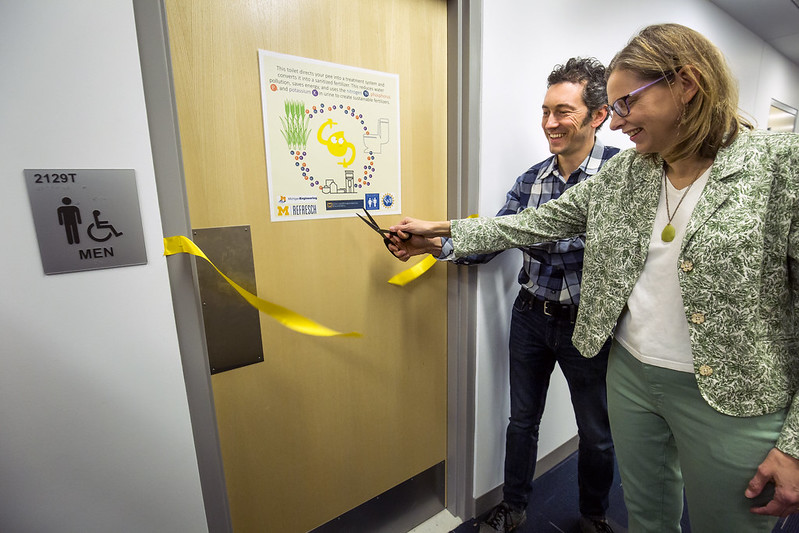
Transforming how communities treat and perceive wastewater
CEE-Led Research Part of NSF Grant to Advance Equitable Water Solutions

CEE-Led Research Part of NSF Grant to Advance Equitable Water Solutions
Nearly a quarter of the clean, potable water that flows through US buildings is not used for drinking. Instead, it moves human waste from toilets to treatment plants in an entrenched approach that’s expensive, wasteful and contributes to nutrient pollution that, in turn, can threaten drinking water supplies.
Through a new grant from the National Science Foundation (NSF), a University of Michigan-led project will work to shift this “use, then dispose” linear system to one that’s circular, sustainable and equitable.
The project, titled Advancing Equitable and Circular Water Solutions Through Source Separation, is one of 15 recently funded with a total of $9.8 million through the NSF Convergence Accelerator program. Collaborators include contributors from nonprofits Rich Earth Institute, The Water Research Foundation, and PHLUSH; startup Brightwater Tools; researchers at the University at Buffalo, Northwestern University and Columbia University; and regulatory consultant Mathew Lippincott.

“Source separation” is the practice of routing different types of wastewater separately from the outset, making treatment and nutrient recovery easier, cheaper and more energy efficient. Urine contains nitrogen, phosphorus and potassium, which are considered pollution when they wind up in freshwater supplies, but are valuable nutrients in fertilizers. Plants need them to grow.
In source separation, a split-bowl toilet can collect urine to be treated, sanitized and converted to fertilizer, while it sends solid waste to a treatment plant.
“The majority of nitrogen and phosphorus that enters our communities comes in the form of food. Of the food we eat, the vast majority of it ends up back in the environment through conventional wastewater treatment plants in a dilute, reactive form,” said Nancy Love, the Borchardt and Glysson Collegiate Professor and the JoAnn Silverstein Distinguished University Professor of Environmental Engineering in the U-M Department of Civil & Environmental Engineering.
She emphasized the inefficiency of current water treatment methods, which allow a significant portion of these nutrients to enter the water stream as pollutants.
Abe Noe-Hayes, research director at the Rich Earth Institute, underscored the impact that source separation can have. The Rich Earth Institute has been operating the country’s first community-scale urine recycling program since 2012.
“About 75% of the nitrogen pollution in wastewater comes directly from human urine,” Noe-Hayes said. “If urine can be captured and turned into fertilizer, it reduces water pollution and supports sustainable agriculture. We are very excited to collaborate on bringing this groundbreaking approach to more communities.”
Through an interactive process encompassing workshops and stakeholder collaborations, the team will flesh out a scalable strategy to fulfill grant objectives.
“Our goal is more than a technological shift; it’s cultural, too,” said Love, noting that community-focused initiatives like Pee for the Peonies can foster public discourse and understanding of the importance of resource recovery from water.

The initiative includes four action areas led by collaborating partners:
“The water sector is embracing its role in the circular economy. As part of that effort The Water Research Foundation supports research in the critical area of recovering nutrients” said John Albert, chief research officer at The Water Research Foundation. “We are excited to partner with the University of Michigan to advance the understanding and benefits of source separation.”
The project champions eco-economic benefits by reducing the volume of potable flush water used in buildings and potentially curtailing costs associated with treatment plant expansions.
“This plan really offsets the treatment plant expansions, which are costly,” Love indicated, pointing to the broader implications of reduced taxes, bonds, and lowered potable water consumption.
Lippincott, the regulatory consultant on the team, says this vision for sustainable sanitation will need new approaches for validating its safe operation. Today’s regulations are specific to sewers and septic tanks, he said.
“All the specialists involved—plumbers, engineers, sanitarians, regulators, and inspectors—need ways to check the functions of our system and ensure public health and environmental health are protected,” Lippincott said. “Our team is finding and removing barriers in national and local plumbing codes and product safety standards, and engaging a variety of regulators to create new types of permits.”
Love hopes the state of Michigan can lead and serve as a model for how to make this important shift.
“What we build in our cities for water systems today will be with us until nearly the end of the century,” Love said. “And if we want to circularize the process and utilize the value of these materials in our water system, we have to start changing those systems now.”

Marketing Communications Specialist
Department of Civil and Environmental Engineering